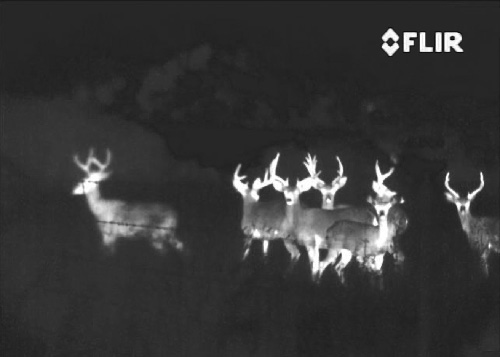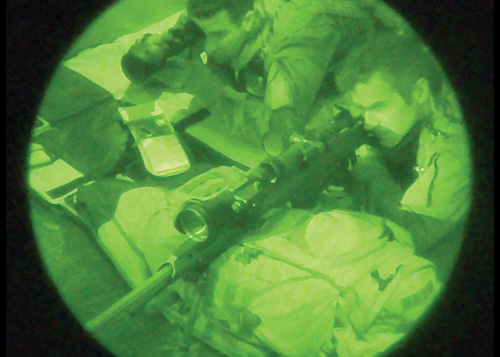There are a number of key differences between the thermal imagers FLIR makes and image-intensified night vision devices you will find from Armasight (NVDs)
From a technological standpoint there are very different things happening when you use thermals compared to running an NVD. But there's also some decisions to be made about what might work best for you, depending on what you are asking your equipment to do.
Night vision intensifiers are amplifying the existing light. This means that the tube inside of them is enhancing light that is barely there and filtering it through a series of photon replicating micro channel plates to your eye. There's a lot more going on in there, but the key idea is that an NVD takes the light already present and makes more of it.
Thermal imagers on the other hand use a microbolometer to detect the infrared radiation emitted by objects around you. When infrared radiation is focused onto the uncooled detector, the heat absorbed causes changes to the electrical properties of the detector material. These changes can be compared to a base value and used to create a thermal image. The key advantage here is that thermals will highlight and differentiate the environment regardless of light. Rather than brightening the image, they are reading the radiation which produces a spectrum of different heat levels.
At its most basic, Night vision comes in three common generations, with an auto-gating feature that can be applied to any of them.
Similarly, Thermal imagers come in three common resolutions, also with a high refresh-rate feature that can be applied to any of them.


That's a hard question. Most western militaries issue their soldiers with NVGs of some kind, as the ability to conduct operations at night has proven a major advantage in all recent conflicts. Thermal units have come down dramatically in price, more than 50% in the past ten years to the point that they are similarily priced to night vision units.
Gen 1 nightvision is at a very reasonable price point, but it borders on being unusuable with its filmy view and limited range. The starting point for a thermal camera is much higher, $1999 for the FLIR PS24 but you get the full functionality of the technology out of the box. A solid Gen 2 device will run between $1300 and $2500, which is a similar point to the starting FLIR units.
The prices escalate similarily between the technologies. The FLIR LS64 with a 640X512 detector and running at 30hz is only $5999. While a PVS-14 in Gen3 with an ITT tube is closer to $4999. A long distance FLIR unit can cost over ten thousand dollars, and enhanced multi-tube night vision devices can be similar.
Those expensive long distance thermal units do have the benefit of reaching further than any hand held night vision device. A FLIR BTS unit with a 100mm lens can reach out over a kilometer, while most night vision scopes are only 3X or 5X magnification. There's nothing in the lineup of traditional nightvision devices that will do long range like the BTS units with their telephoto lenses.
Night vision devices are better for close range awareness and navigation though. Because all these units are sensitive to IR light you can use a variety of tools like beacons, strobes, friendly indicators, and IR lasers that are only visible to people wearing nightvision. Thermal units only identify heat, so they don't care which uniform your wearing, but they can pick out a camouflaged person from their surrounding instantly.
They are ideal for detection, but limited when it comes to identification.
FLIR units are also easier to pickup and use. Make sure they're charged, and that's pretty much all the maintenance they need. There's no finicky focusing like the first two generations of NVDs, and no light restrictions at all. This means they also aren't constrained to night-time activities. As an outdoorsman, FLIR can have multiple roles in your pack: As a scanning tool, as a confirmation tool, and as a night navigation unit.
For anyone hunting or looking to remove varmints, the detection abilities of FLIR are excellent. The Armed Forces keep FLIR options in most vehicles and spotter teams because of its superior ability to isolate potential threats and anything of interest in an environment.
But an image intensified device can often give you useful information that might have been missed through a FLIR.
From our experience, the ideal system allows a user to carry two devices and switch between both on the fly. But what do you think? Thermal or NVD? Feel free to comment here, or join the discussion on our Facebook page.